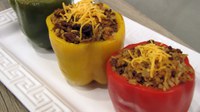Prairie Fare: Where’s Your Food Thermometer?
(Click the image below to view a high-resolution image that can be downloaded)
By Julie Garden-Robinson, Food and Nutrition Specialist
NDSU Extension
“Hi, I’m Julie. What’s your name?” I asked the woman sitting at the table at a food safety conference.
She responded with her name and place of work, and asked me where I work.
“I work at North Dakota State University,” I replied.
“I went to college there,” she said enthusiastically.
“What was your major?” I asked.
“I majored in food science and minored in food safety almost 20 years ago,” she said.
“I must have been your instructor,” I replied as I held up my name badge.
I was feeling fairly ancient now. I’ve worked with a lot of students in the past couple of decades.
“Yes, you were my instructor,” she noted. “I have a story about you that you would not know.”
I was wondering where we were headed with a story about me. I was young back then. What had I done in class?
“I remember you coming to a restaurant with your family where I worked,” she said. “It was ‘two for Tuesday’ burgers.”
This person had an incredible memory. My kids would have been 1 and 4 back then.
“We had burgers going back to the kitchen because they were undercooked,” she said. “I told the cooks that they could not undercook the burgers for my food safety instructor! I told them they better use a food thermometer.”
I laughed when I heard the story. Obviously, our burgers were sufficiently cooked.
Unfortunately, as I learned in our conference talks, many people still undercook or overcook meat. Undercooking is a safety issue, while overcooking is a quality issue.
So, I need to ask my readers a couple of questions: Where is your food thermometer? When was the last time you used it?
If you don’t have a food thermometer, you need to get one. I make this recommendation based on what I heard from research scientists, regulators and educators at the national food safety conference.
According to the U.S. Department of Agriculture (USDA) and Food and Drug Administration, only about one out of three people uses a food thermometer when cooking hamburgers.
Using a food thermometer doesn’t mean that you are cooking food to a blackened, rubbery state. Food thermometers ensure safety and quality. Here are the temperature rules from the USDA:
- Hamburgers, sausages and other ground meats should reach 160 F.
- All poultry should reach a minimum of 165 F.
- Whole cuts of pork, lamb, veal and beef should be cooked to 145 F, as measured by a food thermometer placed in the thickest part of the meat, and allowed to rest for three minutes before eating. A “rest time” is the amount of time the product remains at the final temperature after it has been removed from a grill, oven or other heat source. During the three minutes after meat is removed from the heat source, its temperature remains constant or continues to rise, which destroys pathogens.
- Fish should be cooked to 145 F.
- Meat and poultry cooked on a grill often browns very fast on the outside. By using a food thermometer, you can be sure items have reached a safe minimum internal temperature needed to destroy any harmful bacteria that may be present.
I told my husband the story of meeting one of my students.
“You never know the influence you have on someone,” he commented.
I thought back to our early parenting adventures with an infant and toddler in tow, braving a restaurant and child seats. We even added a third child along the way during the past two decades.
We always have had several food thermometers in our kitchen drawer, and they get used daily.
Here’s a fun recipe that a child or grandchild could help you make.
Stuffed Bell Peppers
3/4 c. brown rice
1 Tbsp. canola oil or other cooking oil
1/2 small onion, minced
1 tsp. garlic, minced
2 Tbsp. fresh cilantro, chopped
1 pound extra-lean ground beef
1 tsp. cumin powder
2 Tbsp. Italian seasoning
1/2 c. tomato paste
1 c. low-sodium chicken broth
1/4 c. cheddar cheese, shredded
3 large bell peppers (red, green or yellow)
Prepare brown rice according to package instructions. Preheat oven to 400 F. Heat oil in a pan over medium heat; add onion, garlic and cilantro. Saute for two minutes. Add the ground beef and brown with cumin and Italian seasoning. Add tomato paste and 1/2 c. of the chicken broth, and simmer five minutes. Stir in the cooked rice and cheese. Cut the top off the bell peppers and remove seeds. Place the peppers standing up in a baking pan. Fill each pepper with the beef mixture. Pour the remaining chicken broth into the pan. Cover top of pan with aluminum foil and bake at 400 F for 35 minutes. Be sure the internal temperature of the meat and rice mixture is at least 160 F.
Makes six servings. Each serving (1/2 stuffed pepper) has 260 calories, 9 grams (g) fat, 20 g protein, 22 g carbohydrate, 4 g fiber and 220 milligrams sodium.
(Julie Garden-Robinson, Ph.D., R.D., L.R.D., is a North Dakota State University Extension food and nutrition specialist and professor in the Department of Health, Nutrition and Exercise Sciences. Follow her on Twitter @jgardenrobinson)
NDSU Agriculture Communication - March 14, 2019
| Source: | Julie Garden-Robinson, 701-231-7187, julie.garden-robinson@ndsu.edu |
|---|---|
| Editor: | Ellen Crawford, 701-231-5391, ellen.crawford@ndsu.edu |


